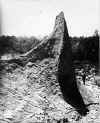"A German named Lilienthal, after experimenting for 23 years with artificial wings, has succeeded in raising himself, weight 160 pounds, with the aid of a counterweight, lifting 80 pounds. How to raise the other 80 pounds is still beyond him." Lilienthal’s death, according to Wilbur, "aroused a passive interest which had existed from my childhood, and led me to take down for the shelves of our home library a book on Animal Mechanism by Prof. Marey, which I had already read several times." Wilbur already had the inkling of an idea. He guessed – correctly – that Lilienthal had died because he could not adequately control his glider. Lilienthal, in fact, had no controls. He hung beneath the aircraft and threw his legs this way and that, shifting his body weight to keep it balanced. Wilbur also guessed that nature must have provided birds with a better method for balance and control, but he didn’t find it in Marey’s book. Over the next few years, Wilbur discussed the problem of controlling an aircraft with
Orville. In May of 1899, Wilbur wrote to the Smithsonian Institution for a list of
publications on aeronautics, then systematically read everything he could on flying. He
was disappointed with what he found. "At that time," Wilbur later observed,
"there was no flying art in the proper sense of the word, but only a flying
problem." |
Click on a
photo to enlarge it. Wilbur often rode his bicycle out to the "Pinnacles," strange geologic formations that overlooked the Great Miami River. From here, he studied buzzards as they soared. |
In Their Own Words
|
 Wilbur's letter to the Smithsonian. |